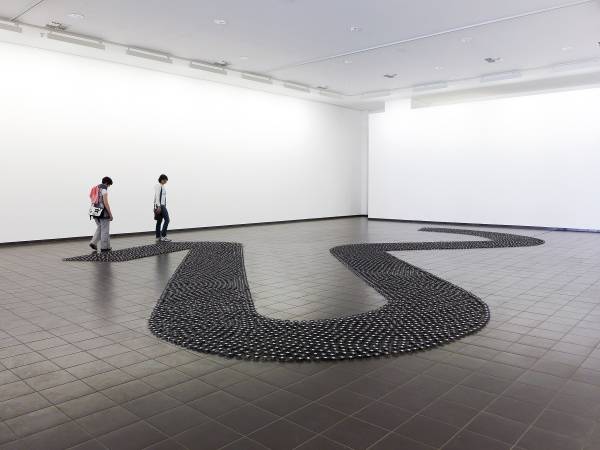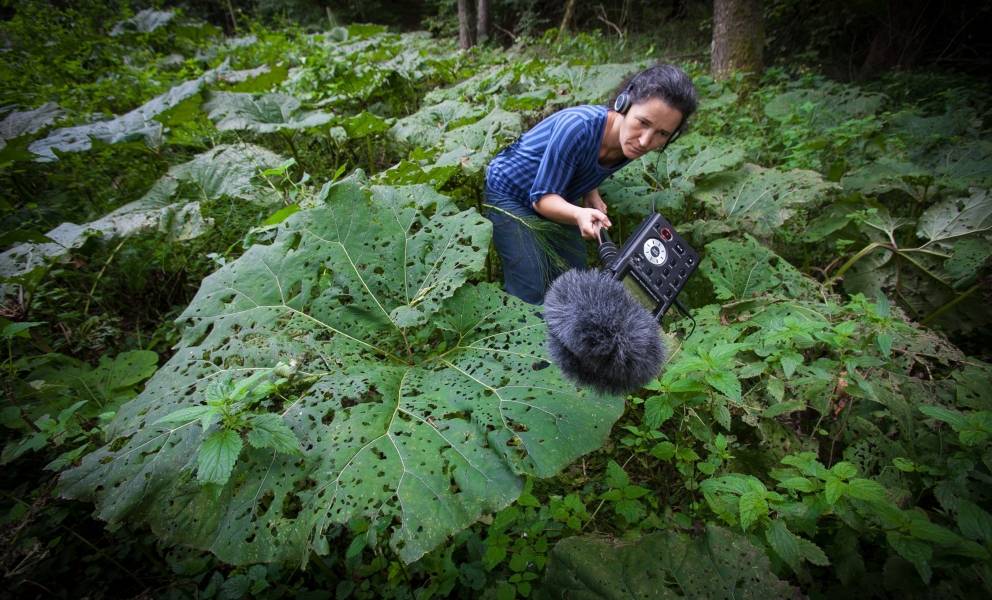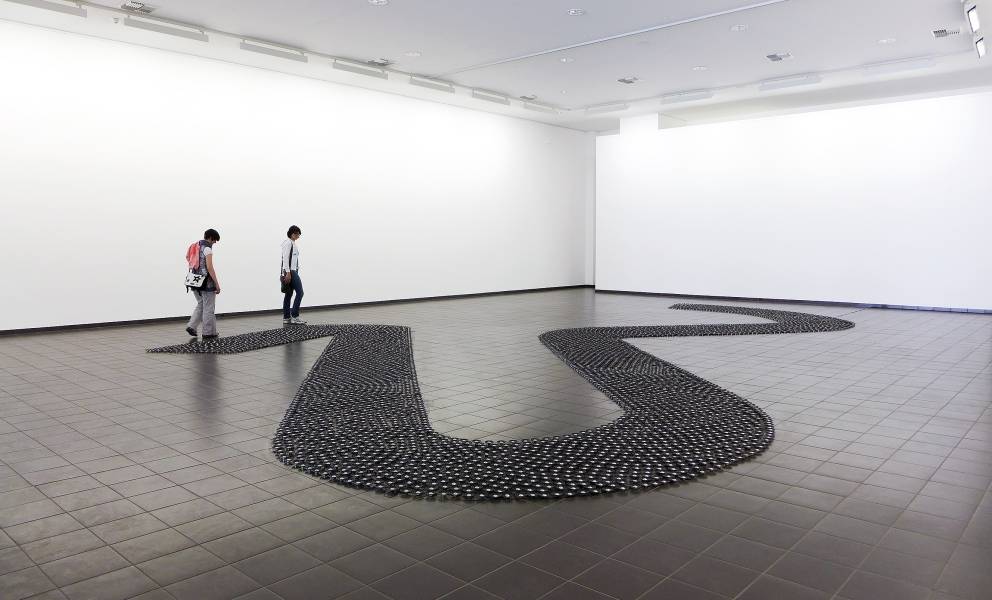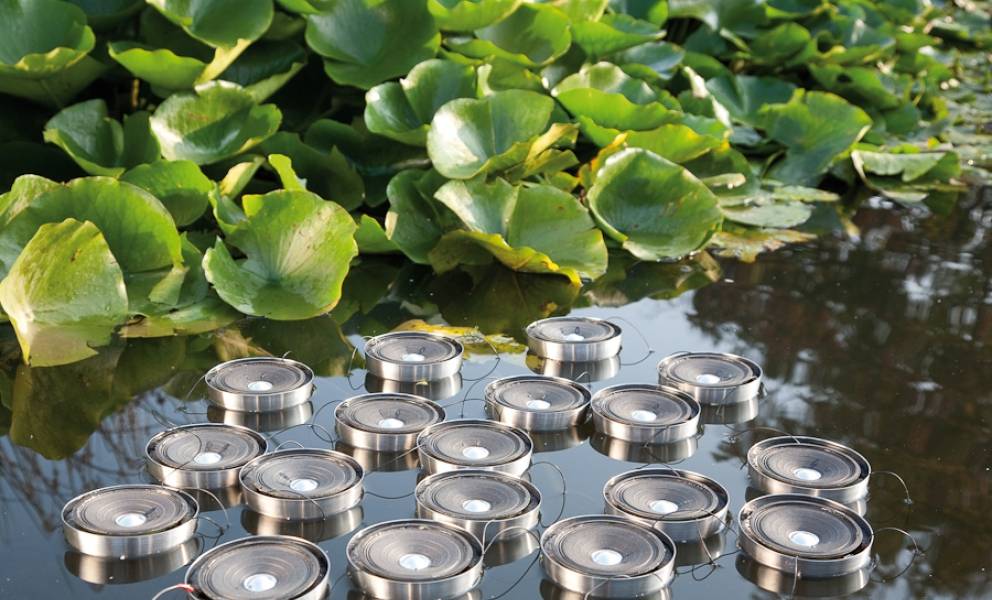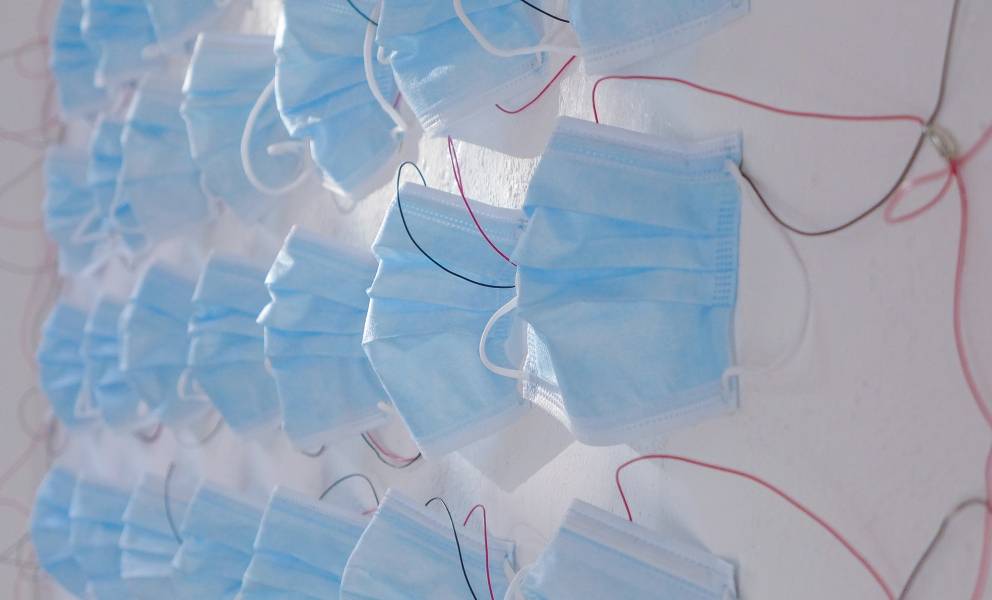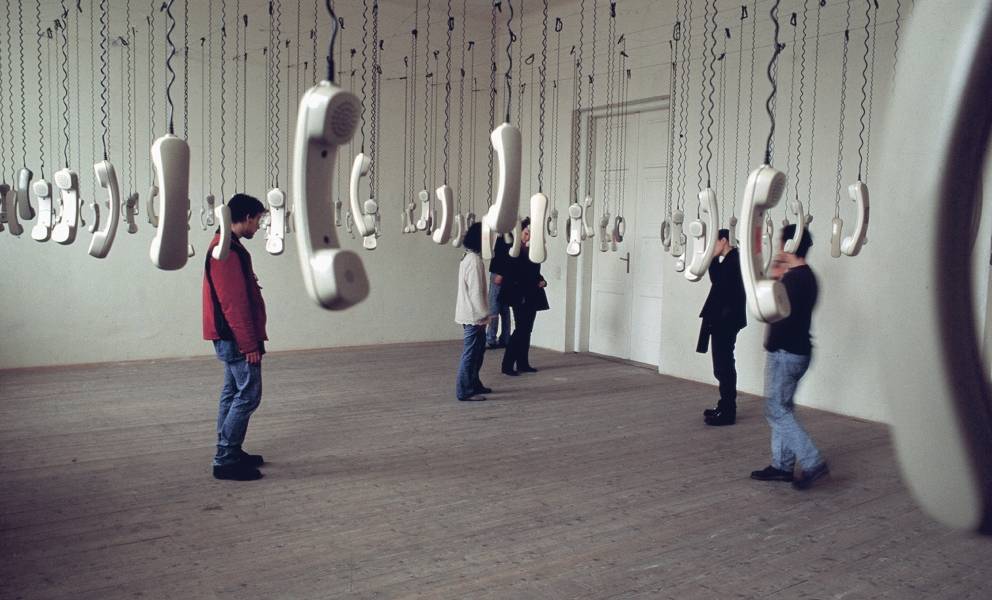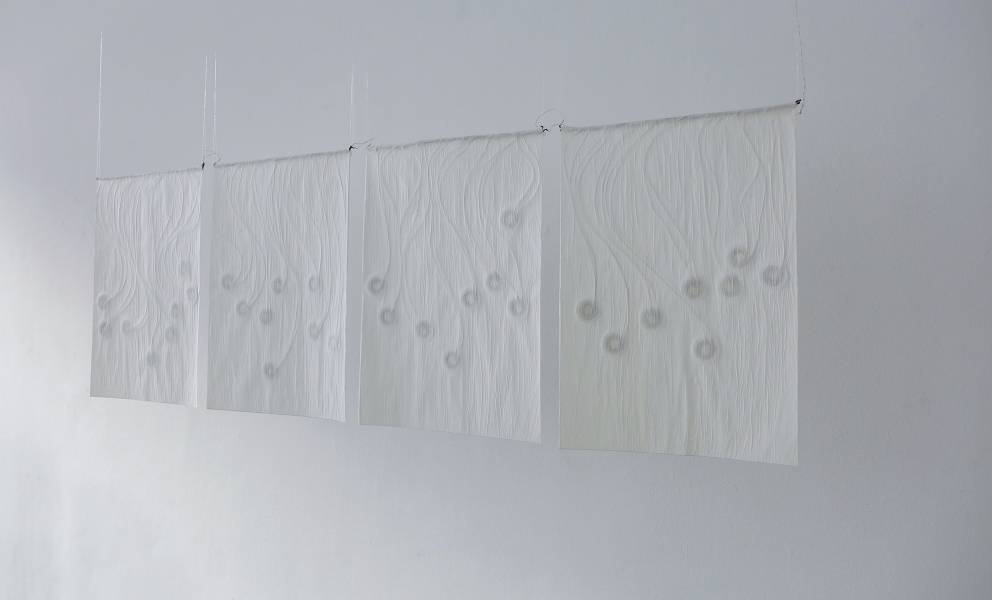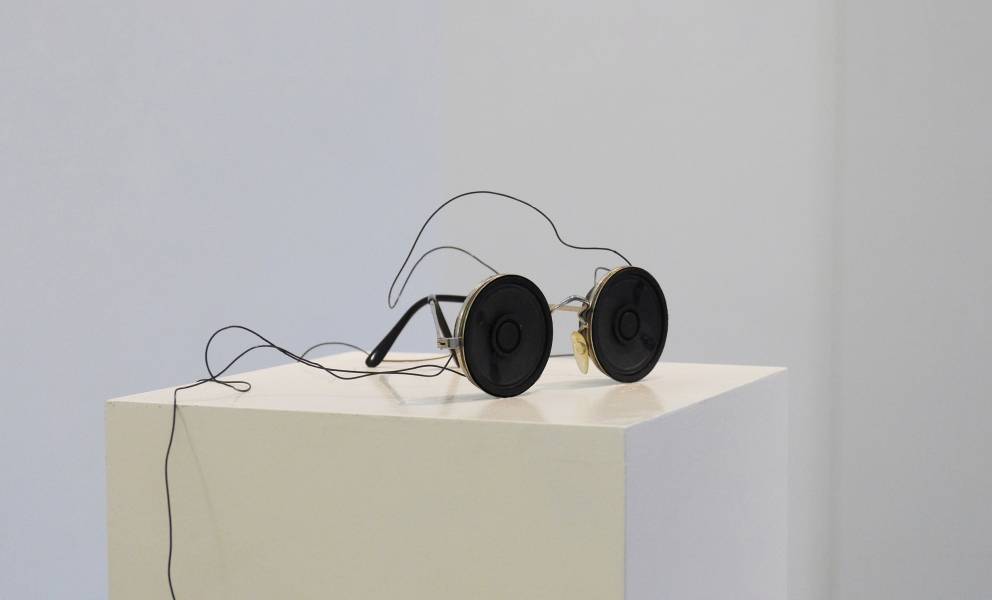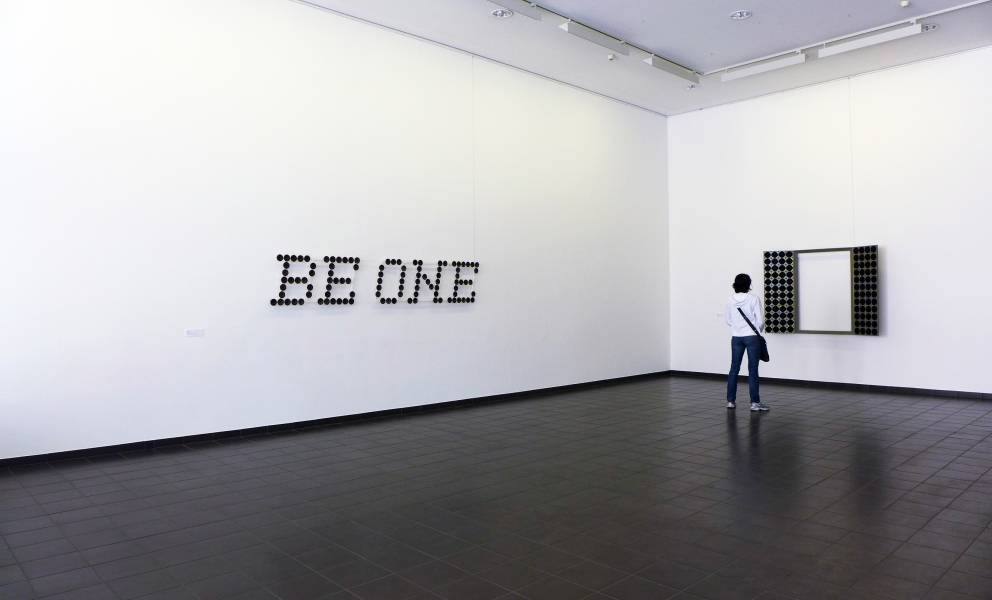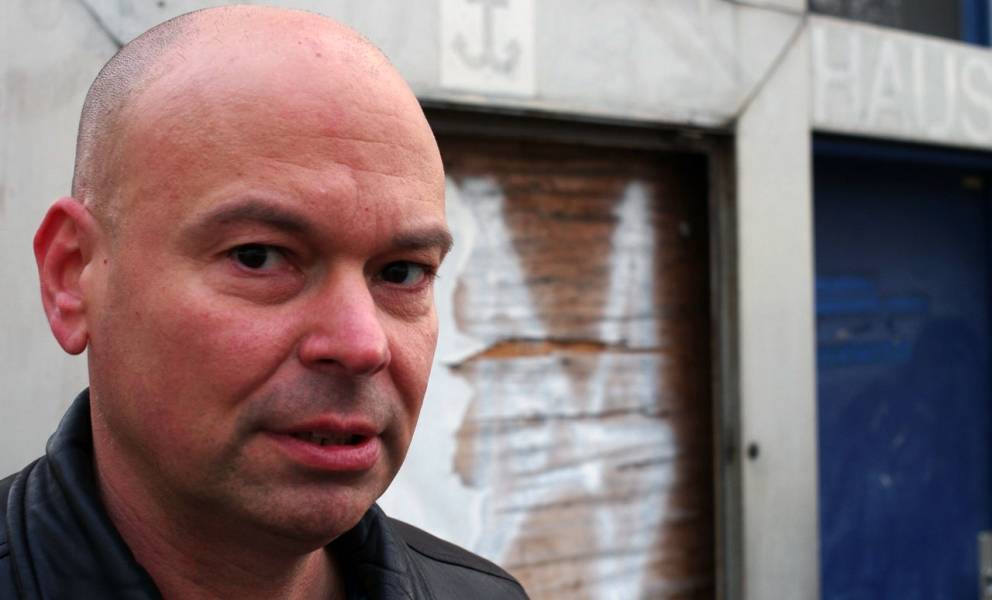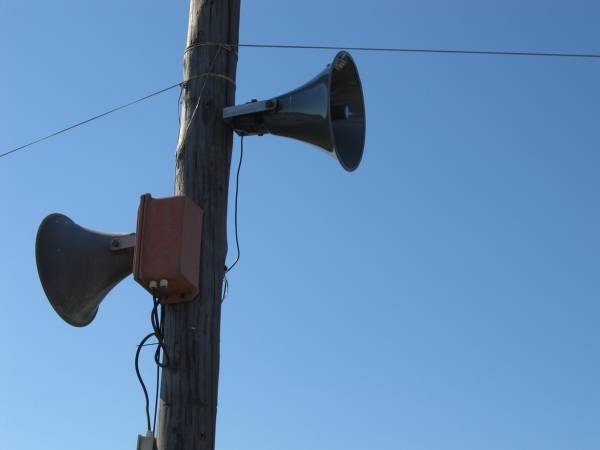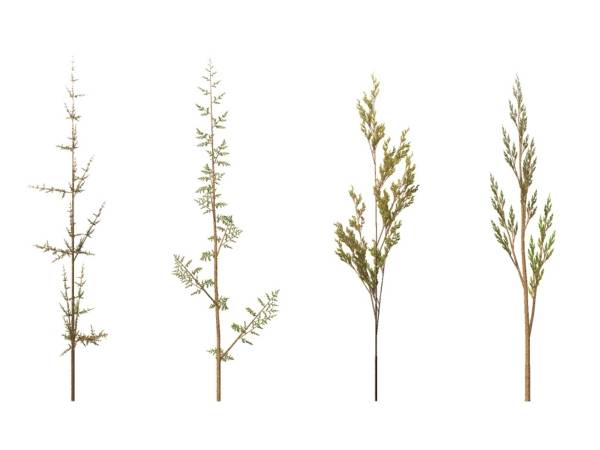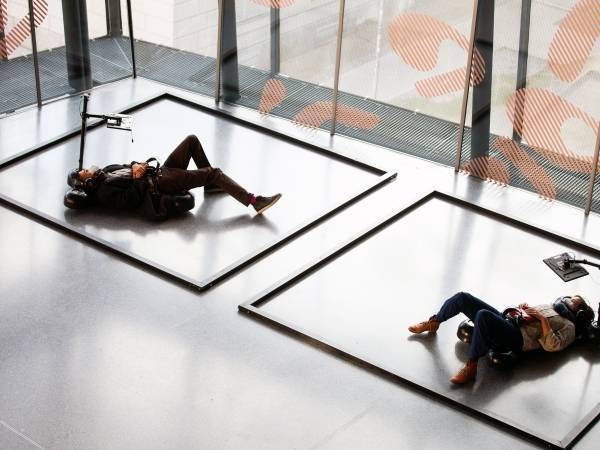14 Minuten
That’s not to say that even traditional art, art created before the avant-garde productions of the 20th century abandoned all borders, couldn‘t or didn’t arouse the auditory imagination. Of course, it did. How might it have sounded – a storm at sea, the hurly–burly of a battle, the rowdiness of a country fair, or the rumbling, screeching, and snorting of a steam train? But nobody would maintain that artists formerly painted only to trigger the fantasies of the viewer’s inner ear. Sound associations used to be at most a secondary aspect. But the amalgamation of sound and art is something quite different, and the term sound art is comparatively very new.
The sound artist Clara Oppel knows her craft, which is not necessarily the case in a field like sound art, where the concept sometimes has fuzzy edges. In sound art, creative parameters like time and space come into close contact, and in fact, intermingle. Sound here is detached from a performance situation, and in fact from any sort of context where musical events have a defined beginning and a defined end, as with a recording. Sound here is embedded in a constructed space in which – unlike in concert halls – absolutely any perceivable aspect can acquire significance – even when the creators of a sound installation only set up some loudspeakers and connect a few cables. This observation is as trivial as it has enormous implications, which sound artists just can’t help thinking about. Looked at in this way, sound art, in which aspects of spatial as well as temporal art are all parts of the process, is a particularly demanding and challenging art, especially when, as with Oppel, it’s uncompromising and never takes the easy way out on the acoustic and the sculptural levels. When I write that Clara Oppel knows her craft, I think of craft in the plural. There is the craft of the sculptor, who makes things that can be seen or felt, but also the craft of a sound sculptor, who makes things that speak to a different faculty of perception. There is no clear term for this facet of craft. It’s important to Clara Oppel that she is not regarded as a composer, but the audio tracks of her works are nevertheless as elaborate and subtly designed, even composed, as radio productions by radio artists, to which we willingly devote our undivided attention. Some of her works have also been broadcast as radio productions. But they are compositions for spaces. Of course, compositions have always been created for specific spaces, such as churches or concert halls. But in sound art, the space plays an incomparably greater role.
As the musicologist Helga de la Motte-Haber points out: ‘to create sound at all is to create it in a space.‘ And she continues: ‘sounds are information about the space. even when the sounds contain information, which, like traditional concert music, presupposes a culturally acquired system of signs, they can’t be completely removed from spatial references. Even though recording media make, so to speak, portable concert halls possible, art situated in a real space possesses a special quality and power of attraction. the close relationship of art to its surroundings applies equally in the field of visual art.‘ Clara Oppel thus conceives art for the spaces she fills with sound, which is site-specific to a special degree, in a sense doubly so, because it is site-specific on two media levels. Her finely staged listening spaces do not always find it easy to assert themselves against the media overkill of contemporary art. For Oppel doesn’t go the might-is-right way of elbowing herself into the foreground with her sound interventions and thereby simply drowning out the acoustic environment. On the contrary, she often quite consciously integrates the ambient sounds into her works and creates open, permeable listening spaces.
As early as 1995, the art historian Michael Glasmeier pointed to a trend that has since become largely uncontroversial business-as-usual in the exhibition road-show of biennials and museums, a trend that doesn’t make waves: ‘Almost everywhere art appears it beeps, whispers, rattles, makes noise, or even vocalizes to an admittedly enjoyable extent. The viewer‘s peace and quiet is a thing of the past, especially now, for example, when in museums with their open doors and passages, even the most minimal sound phenomenon often invites an unexpected reaction. The days of quiet contemplation in front of the work of art are over. Art has become an event, something that attracts attention acoustically, topeace set time oscillating in space.’
This description might well be accurate, but it would nonetheless be a mistake to draw the conclusion that sound art has finally begun its triumphant procession through the world’s art galleries. On the contrary: integrating acoustic layers into room-sized installations – not to mention all the films shown within exhibitions, most of which also have a soundtrack – is done all too often in a less than subtle, in fact obtrusive, manner, so to speak with a very rough paint-brush. The aim is to attract attention; and sound is, psychologically speaking, a tried and tested means of doing this – in the amusement parks of big exhibitions. After all, it is easier to look away than to ‘hear away‘, just block out all the beeping, rattling and vocalizing. This particular sound artist, however, works precisely and deliberately on the sounds she wants to make audible in a given space. In Clara Oppel‘s work, the visible and the audible develop so to speak hand in hand. She speaks of working ‘at the interfaces of sound, space, installation, and sculpture‘ and writes: ‘How I deal with the sound is equally decided by the visual moment.‘ i.e.: she doesn‘t start with sculptural ideas and then think about sounds to go with them. But the opposite is equally true, and she also doesn‘t start her deliberations the other way round either, with a finished audio creation, around which she then builds a frame, as it were. Rather, Oppel ’s starting point is both spaces and their sounds. And the acoustics of exhibition spaces are often intricate, traditionally playing only a minor role in the architecture of museums and gallery spaces. Such rooms are tailored to present works of visual art optimally. They are often very big, with high ceilings and lots of reverberation. By now, Oppel has become a virtuoso in confronting these spatial challenges.
Sound sculpture. 5400 dome loudspeakers, stranded wire, spatial audio system, 8-channel composition. Marburger Kunstverein, Marburg, Germany - 2015.
Take for example breathing space, a floor work conceived in 2015 for the Marburger Kunstverein, in which no fewer than 5,400 dome loudspeakers were used; or texere in the Gasteig in Munich, where in the year 2020 Oppel installed loudspeakers on a wall facing a glass front so that the reflection created a spatial sound experience. But she has also taken on the acoustics of a long, walled-in corridor in Neustadt am Rübenberge or sent loudspeakers floating between water lilies on the Funkhaus pond in Graz.
Concert installation. 100 loudspeakers, cables, bowls, 4-channel audio. A cooperation project of ESC Labor and steirischer herbst in cooperation with musikprotokoll 2009. Funkhausteich - ORF Landesstudios Graz, 2010.
Clara Oppel‘s sound installations cannot be separated from the spaces in which they are experienced. The artist speaks of wanting to achieve a symbiosis of picture and sound. She does not travel – as perhaps a sculptor or a painter does – with finished works in her luggage that then only have to be set up in a museum or a gallery. She develops her work largely on-site. Her color palette consists of various types of speakers, transducers, and cables that she keeps in store and selects, depending on the occasion. It is not uncommon for Oppel‘s installations to include several thousand small loudspeakers. Setting them up is then demanding and takes several days. These sound installations are, strictly speaking, not transplantable or repeatable. And it is also difficult to document them. The question then is whether to even make the attempt to recreate the soundscape as experienced by a visitor or listener in a particular place – especially considering that sound experiences, even in the same space, can be very different depending on the respective vantage point. Or whether it would be more appropriate just to bring the pure audio piece that comes out of the many loudspeakers. Add to that the fact that these are often four or eight-channel works that standard stereo equipment just can’t handle. And if even the best catalog print can convey only a hint of the effect that painting and graphics can have, sound art is fleeting and even more difficult to depict. So any catalog that sees itself as the temporary sum of this eye- and ear-stimulating oeuvre should be regarded as an invitation to visit the places where Oppel’s works can be experienced.
Clara Oppel‘s sound installations do not impose themselves on the visitor. Often the listeners, which is what the artist’s sound interventions make visitors into, wonder whether they are just hearing sounds coming out of the loudspeakers or a ‘composed‘ audio creation. Oppel often increases the confusion by making field recordings in the exhibition space itself or the immediate vicinity – she calls them ‘acoustic photos‘ and then processing them even further within her installations – always interacting with the prevailing circumstations of the space, in which she deliberately builds in clues guiding the viewer‘s gaze. Some sound artists are only interested in staging an acoustic space, therefore either hiding loudspeakers and cables or accepting them as a necessary evil, or at least not using them sculpturally. Clara Oppel is quite different, always developing her installations in the elusive space connecting the visible and the audible. She employs volume as a creative feature only very sparingly, which of course greatly enhances its effect. People who are attracted by the sound space, and involve themselves consciously with a work by Clara Oppel, will soon find their way around it. This sound artist uses the factor of time responsibly, something that not everybody does. She does not play endless audio tracks over the loudspeakers, forcing visitors to stand around for hours in the hope of really understanding the meaning. She accepts that whenever she constructs something in an exhibition or a public square, she is working in a transitory public space, which people pass through, enter on one side, and leave on the other, places of passage, where there is a constant coming and going and where there is no captive concert audience from whom she can expect undivided attention to her acoustic event for a longish period. But what might seem like a restriction turns out to be the contrary: she creates transitory listening spaces that visitors can perceive and respond to on their way through, often interacting with the work, the artist, or each other. Her compact audio pieces – whether they are field recordings or edited voice recordings – seldom take longer than a few minutes, which enables visitors to genuinely grasp the acoustic level and perhaps even experience it from various listening positions.
In a work permanently installed in the KunstGarten in Graz, Oppel‘s audio piece weaves itself subtly into the soundscape of a garden, which of course also changes constantly with the seasons: darüber hinaus (beyond that) is a special example of visual restraint. Far from intervening visually in the garden, which already has so many sculptures and other artistic works interacting with each other, Oppel limited herself to hanging four loudspeakers among the vegetation as an element which, except in winter, just isn’t visible at all.
But even when she – with her sculptor’s way of seeing things – does actually shape spaces, Clara Oppel always proceeds very sparingly and often restricts herself entirely to simply arranging many tiny loudspeakers, which sometimes form ribbons passing over walls and floors or combine to form letters. Other visual additions are extremely rare. In an installation that could be seen and heard in Solothurn in 2021, 126 sound transducers were arranged under 126 sanitary masks.
Sound installation. 126 hygiene masks 126 sound transducers, stranded cable, audio system, 2-channel composition. Künstlerhaus S11, Solothurn, Switzerland - 2021.
In an installation that Oppel created for the Kunstverein rotor in Graz in 2020, the arrangement of the loudspeakers on the wall form a strikingly abstract pattern, reminiscent of drawings by the artist.
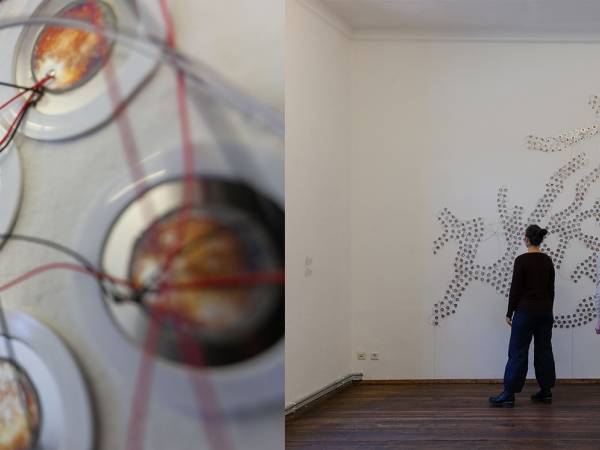
Sound installation. 1160 piezo transducers, stranded wire, spatial audio system, 4-channel composition, 4.5 x 3.5m. < rotor > Center for Contemporary Art, Graz - 2020.
For Clara Oppel, technology is a tool, a means to an end. While she certainly knows how to make masterful use of it, it recedes into the background. She is by no means a technology fetishist. In a sound sculpture from 1999, telephone receivers hang from the ceiling on cables and imbue the exhibition space with sound. Visitors could choose their position between the handsets hanging at ear level, which served as loudspeakers.
Sound installation. Telephone receiver, cable, audio equipment, 20-channel composition. 11.50 x 7.15 x 3.40m. Academy of Fine Arts Vienna, 1999.
Even though it’s only around twenty years since landline telephones and cables of this sort were ubiquitous, the sight of these things, which have now vanished from our everyday environment, feels most peculiar – like the many old-fashioned television sets in Nam June Paik‘s work. And cables will probably soon be gone as well, replaced once and for all by wireless connections. But for the here and now though, they are still an important design element for Clara Oppel – flexible lines that she can distribute throughout the space, attach to the wall, or form into structures on the back of parchment sheets as in Simorgh I. That title alludes to a mythical creation of the Persian poet Farid Uddin Attar and his book Bird Talks.
Sound object/loud poem. 4 sheets of parchment, piezo sound transducer, stranded wire, 2-channel audio, 80 x 100cm. Marburger Kunstverein, Marburg, Germany - 2011.
A clarification is necessary at this juncture. In Clara Oppel‘s work, there are not only the sound sculptures, basically unrepeatable spatial designs, but there are also so-called sound objects, such as Simorgh I: the four parchment sheets with the built-in sound transducers can be hung in different places – which, of course, does not mean that they sound the same everywhere. So the sound artist has to be on site to decide on the exact positioning. The Schale aus Wort (bowl made of words) is also a sound object, as is unterwegs (on the way). The Schale aus Wort consists of loudspeakers that can be spread out over the listeners, like an umbrella, or can fill the room with sound from the floor. With unterwegs, loudspeakers spill out of an old-fashioned suitcase. Clara Oppel also calls Simorgh I and Schale aus Wort ‘sound poems.‘ This emphasizes the fact that language plays a prominent role in many of her works – but not an everyday language as a medium of understanding that would set semantic signposts in the space Oppel occupies. The term ‘sound poem‘ refers to the fact that here the acoustic dimension of language comes to the fore, that language is heard musically beyond the semantic content of words. Gerhard Rühm speaks of ‘auditive poetry‘. In Clara Oppel‘s case, she does not work with sound poems and integrate them into her audio pieces. To a certain extent, sound poetry is created through editing. Spoken language is chopped up, rearranged, and compressed. The sound artist even goes so far as to edit texts recorded for her by the writer Christian Loidl, who died in 2001. Her editing is so intrusive that the semantics completely evaporate and they become purely speech music. For example, In the installation Schlafstimmen, Christian Loidl‘s voice can be heard issuing from cups and teapots. In this context, Friedrich W. Block speaks of ‘language-based sound art‘ and applies the term to a very essential part of Clara Oppel‘s work.
Object without sound. 150 x 20 x 20cm, loudspeaker, stranded cable. Kunsthaus Essen, Germany - 2007.
But there is not always something to hear in Clara Oppel‘s work. Schlechte Brille (bad spectacles) for example, is an object without sound. It was exhibited at the Kunsthaus Essen in 2007 and demonstrates the omnipresent humor of the sound artist. Instead of lenses, loudspeakers are inserted into the frame of the glasses. Cables hang from them, but only loosely, with no connection to a sound source; nothing can be heard. You can‘t see with these glasses, but you can‘t hear anything through the speakers that replace the lenses either. Here, rather than going hand in hand, image and sound cancel each other out instead. Is this the sound artist being self-ironic, or is it resignation in the face of an acoustical world that is hopelessly polluted? ‘The public space is dominated by dirt and trash. Acoustic trash and visual filth, acoustic and visual din.‘ What Peter Weibel expresses is true. He goes on: ‘the public space is full of advertising and noise. The noise of cars, trams, machines, construction sites, road works, etc.
The public space is full of advertising, publicity, and propaganda. The term public space is a euphemism, a hypocrisy. In fact, “public space“ no longer exists. It is completely privatized by advertising and publicity. It‘s colonized by private companies and by the state, which sells public space to private companies.‘
The music theorist Heinz-Klaus Metzger once said that art music has only two chances to react to the situation outlined by Weibel: either by trying to drown out the noise of the world with futuristic material battles, so to speak; or by a conscious withdrawal, which compels listening. This acoustic disarmament, with which Clara Oppel with her cautious acoustic interventions undoubtedly also sympathizes, seems to me to be clearly the more timely response. Peter Weibel still has great confidence in the comparatively young sound art in this context and would like to see it represented even more in the public space: ‘Sound art should take place not only in the closed spaces of museums, but also in the open urban spaces, in the so-called public space. An acoustic urban art as an aesthetic of resistance must confront the urban sound of city traffic.’
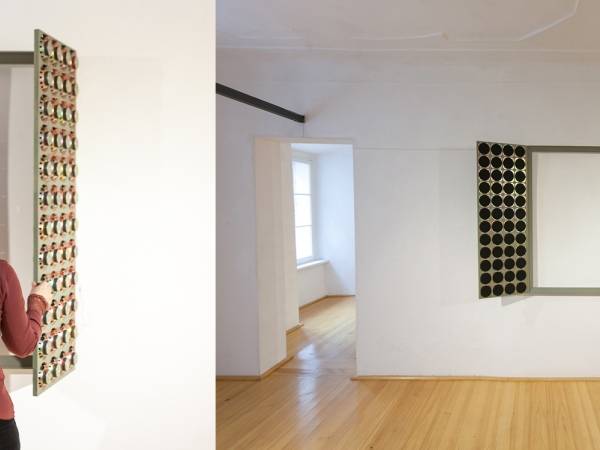
Sound object. Triptych, 96 broadband loudspeakers, stranded wire, MDF, audio system, 2-channel composition, 136 x 194cm. KULTUMdepot Graz - 2013.
A sound object titled Sfumato from 2013 demonstrates particularly well how Clara Oppel tries to create ‘synaesthetic situations‘. Loudspeakers are mounted on the open panels of a window – and especially in an exhibition space, it’s obvious to think of a winged altar. But the center, where one expects a picture, is empty. The frame reveals a white piece of wall. On the acoustic level, white and pink noise can be heard at first, before fragments of speech emerge.
Translation: Keith David Harris
Listen to: Radio Feature: Die Klangkünstlerin Clara Oppel – Innere und äußere Räume
Deutschlandfunk Kultur by Florian Neuner
Florian Neuner
Florian Neuner, born 1972 in Wels, lives in Berlin and, together with Ralph Klever, publishes the magazine Idiome. Hefte für Neue Prosa. As a radio author, he works mainly for Deutschlandfunk Kultur. Recent publications: Für eine andere Literatur. Reaktionen, Rezensionen, Interventionen (Vienna: Klever Verlag 2022), Rost. Eine psychogeographische Expedition (Klagenfurt: Ritter Verlag 2021).
Article translations are machine translated and proofread.
Artikel von Florian Neuner
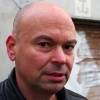 Florian Neuner
Florian Neuner 